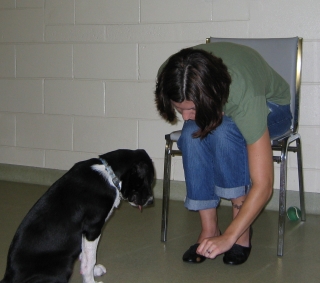Sometimes the Clicker is Quicker

There are people in the industry who dog trainers look up to as heroes, mentors, and gurus. One of our most notable leaders is Dr. Ian Dunbar, who was responsible for bringing dog training methods out of the too-harsh-for-puppies dark ages to the modern reward-based puppy classes of today due to his creation of the lure/reward method of training.
As a new trainer, I started out using only the lure/reward method of training. Then after attending a ClickerExpo and educating myself further in clicker training, I started including more shaping and capturing in my classroom. Both methods are based in positive-reinforcement, both are effective, both are fun, and both are easy for the students and the dogs to learn. But the more I train, the more I love my clicker.
Teaching “down” with a lure
I was never completely satisfied with the lure/reward method when trying to teach a puppy to lie down on cue. The basic method starts with a dog in a sitting position. A treat is placed under his nose and slowly lowered down by his chest to the floor. The hope is that he will follow it with his nose until it is more comfortable for him to lie down.
One problem with this is that once you get the treat to the floor (if he even follows it all the way), you have to move it under the dog’s chest, or pull out with it, or curve it towards his armpit to get most dogs to lower their bodies all the way. What works for one dog is different for the next. As a trainer I learned which way to go with the treat by watching the dog’s body movements, but the owners had a much harder time. Another problem is that the smaller dogs don’t have to lie down to get a treat held to the floor, all they have to do is lower their faces, so they often don’t get the point. They have to be put up on a raised surface and lured below it, or perhaps lured under a leg with the human sitting on the floor, and an already clumsy procedure can become even more awkward.
Once the dog does lie down and the owner marks and rewards it a few times, the next step is to remove the treat and turn the hand movement into a cue signal. Many people don’t fade the treat quickly enough and create a dog who will only lie down if the treat is at their nose. The most frustrating problem I kept running into is that by graduation, even after explaining and demonstrating how to fade the hand signal from touching the ground to standing upright, I still would have a lot of students hitting the deck with their dogs to get them to lie down.
Not to mention that since the dogs are started in a sit, they only learn how to lie down from a sitting position. Most of them would get confused if asked for a down from a standing position.
Teaching “down” with a clicker
Though I do still use lures to teach certain other behaviors, I feel it is much easier and more elegant to capture downs with a clicker. I set my students up at a distance from each other across the room, and chat quietly with the humans to get everyone relaxed. Within a minute or two, most dogs will get bored and lie down. The owner clicks and throws a treat in front of the dog so that he must stand up to get it. Another moment or two goes by, the dog once again lies down – click and the treat is thrown. And then again.
Within a few minutes most dogs are either looking at their owners while they slowly and deliberately lower themselves into a down, or they lie down and then immediately look up for their treat. In either case, the dog is demonstrating that he has learned that the behavior he is getting rewarded for is lying down, and he begins to offer it voluntarily. At this point the owner can say “Down” and give a hand signal just as the dog lowers himself into position. By the second or third time they do this, it’s on cue.
No weaning off lures in front of the nose, no fading the hand signal from the ground to a standing position, and the dog hasn’t gotten into the habit of sitting first. Also the dog has learned how to figure out what the owner wants by using his own creative mind, the owner has learned to tune closely into her dog’s behaviors, and both are usually quite thrilled with the game and each other.
If there is a problem with teaching down this way, it’s that the student may not be able to go on for the rest of the class without bursting into laughter as the dog tosses himself joyfully on the ground every time she looks at him. Moving onto the next step of only rewarding the downs that are cued will take care of that in no time. But getting the dog’s attention off his owner and sending him back into play? That is sometimes a little more difficult!




